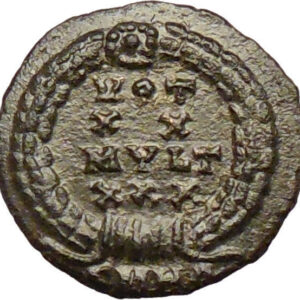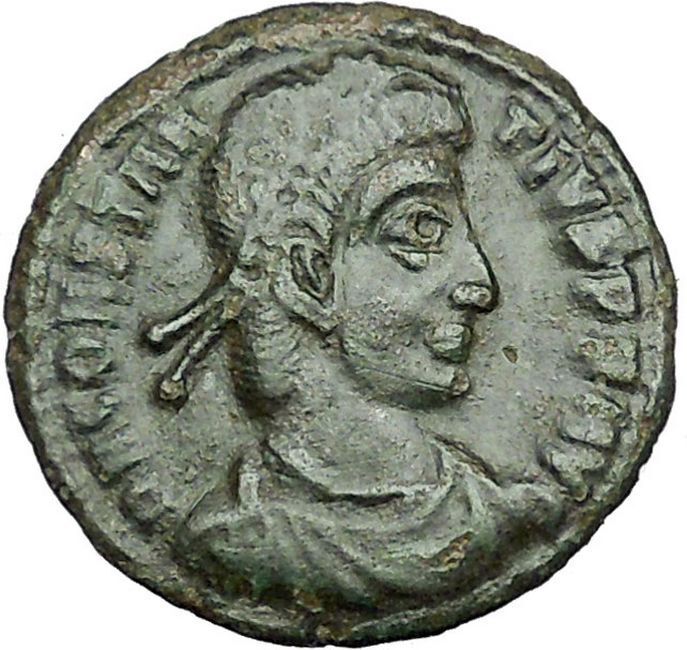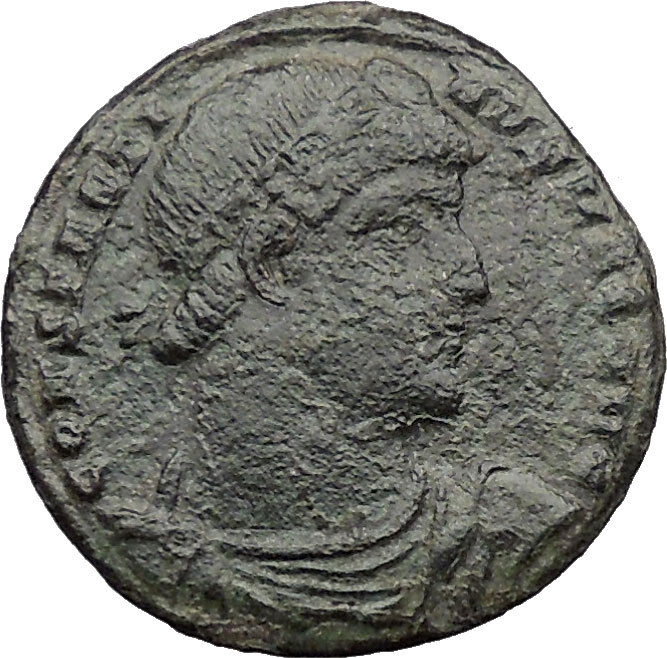|
Lucilla
– Roman Empress Wife of Lucius Verus – 164-183 A.D.
Bronze Sestertius 31mm (24.36 grams) Rome mint: 164-169 A.D.
Reference: RIC 1756 (Marcus Aurelius), C 54
LVCILLAEAVGANTONINIAVGF – Draped bust right.
PIETAS – Pietas standing left, raising hand over altar and holding box of
incense.
SC across fields.
You are bidding on the exact item pictured,
provided with a Certificate of Authenticity and Lifetime Guarantee of
Authenticity.
Pietas, translated variously as “duty”, “religiosity” or
“religious behavior”,”loyalty”,”devotion”, or “filial
piety” (English “piety” derives from the Latin), was one of the chief
virtues
among the
ancient Romans
. It was the distinguishing
virtue of the
founding
hero
Aeneas
, who is often given the
adjectival
epithet pius throughout
Vergil
‘s epic
Aeneid
. The sacred nature of pietas
was embodied by the divine personification Pietas, a goddess often pictured on
Roman coins. The Greek equivalent is
eusebeia
.
Cicero
defined pietas as the virtue
“which admonishes us to do our duty to our country or our parents or other blood
relations.” The man who possessed pietas “performed all his duties
towards the deity and his fellow human beings fully and in every respect,” as
the 19th-century classical scholar
Georg Wissowa
described it.

Livia
wife of Augustus as Pietas
As virtue
Pietas erga parentes (“pietas toward one’s parents”) was one of
the most important aspects of demonstrating virtue. Pius as a
cognomen
originated as way to mark a person
as especially “pious” in this sense: announcing one’s personal pietas
through official nomenclature seems to have been an innovation of the
late Republic
, when
Quintus Caecilius Metellus Pius
claimed it for
his efforts to have his father,
Numidicus
, recalled from exile.
Pietas extended also toward “parents” in the sense of
“ancestors,” and was one of the basic principles of
Roman tradition
, as expressed by the care of
the dead.
Pietas as a virtue resided within a person, in contrast
to a virtue or gift such as
Victoria
, which was given by the gods.
Pietas, however, allowed a person to recognize the divine source of benefits
conferred.
The first recorded use of pietas in English occurs in Anselm Bayly’s
The Alliance of Music, Poetry, and Oratory, published in 1789.
Iconography

Denarius of Herennius, depicting Pietas and an act of pietas.
Pietas was represented on coin by cult objects, but also as a woman
conducting a sacrifice by means of fire at an altar. In the imagery of
sacrifice, libation
was the fundamental act that came to
symbolize pietas.
Pietas is first represented on Roman coins on
denarii
issued by
Marcus Herennius
in 108 or 107 BC. Pietas
appears on the obverse as a divine personification, in
bust
form; the quality of pietas is
represented by a son carrying his father on his back.Pietas is among the virtues
that appear frequently on Imperial coins, including those issued under
Hadrian
.
One of the symbols of pietas was the stork, described by
Petronius
as pietaticultrix, “cultivator
of pietas.” The stork represented filial piety in particular, as the
Romans believed that it demonstrated family loyalty by returning to the same
nest every year, and that it took care of its parents in old age. As such, a
stork appears next to Pietas on
a coin issued by Metellus Pius
(on whose
cognomen see above
).
As goddess

Flavia Maximiana Theodora
on the
obverse, on the reverse Pietas holding infant to her breast.
Pietas was the divine presence in everyday life that cautioned humans not to
intrude on the realm of the gods. Violations of pietas required a
piaculum
, expiatory rites.
A temple to Pietas was vowed (votum)
by
Manius Acilius Glabrio
at the
Battle of Thermopylae in 191 BC
.
According to a miraculous legend (miraculum),
a poor woman who was starving in prison was saved when her daughter gave her
breast milk (compare
Roman Charity
). Caught in the act, the daughter
was not punished, but recognized for her pietasas. Mother and daughter
were set free, and given public support for the rest of their lives. The site
was regarded as sacred to the goddess Pietas (consecratus deae)pietas
erga parentes
Lucilla, Augusta, A.D.
164-182/3
Wife of Lucius Verus
Daughter of Marcus Aurelius and Faustina Junior
Sister of Commodus, Annius Verus and Aurelius Antoninus
Granddaughter of Antoninus Pius and Faustina Senior
Annia
Aurelia
Galeria Lucilla or Lucilla (March 7, 148 or 150-182) was the second
daughter
and third child
of Roman Emperor
Marcus Aurelius
and Roman Empress
Faustina
the Younger
and an elder
sister
to future Roman Emperor
Commodus
.
Lucilla was the younger twin. Her elder brother Gemellus
Lucillae died around 150. She was born and raised in
Rome
.
Lucilla’s maternal grandparents were Roman Emperor
Antoninus Pius and
Roman Empress
Faustina the
Elder
and her paternal grandparents were
Domitia Lucilla
and praetor
Marcus Annius Verus
.
Lucilla in 161, was betrothed to her father’s co-ruler
Lucius
Verus
and they married in 164, in
Ephesus
. At
that time, Marcus Aurelius and Lucius Verus were a fighting a
Parthian
war
in Syria
. She
received the title of Augusta and became a Roman Empress.
Lucilla bore Lucius three children: two daughters and a son.
The first daughter was born in 165 in
Antioch
. The
elder daughter Aurelia Lucilla and son Lucius Verus died young. Lucilla was an
influential and respectable woman and she enjoyed her status. She spent much
time in Rome, while Lucius was away from Rome much of the time, fulfilling his
duties as a co-ruler. Lucius died around 168/169.
Sometime in 169, Marcus Aurelius forced her to marry Tiberius
Claudius
Pompeianus
Quintianus, a Syrian Roman who was twice consul and a political
ally to her father. Lucilla and her mother were against this marriage, because
Quintianus was an older man and Lucilla preferred to marry a younger man.
Lucilla around 170, bore Quintianus a son called
Pompeianus
.
Lucilla and Quintianus accompanied Marcus Aurelius in 172, to
Vienna
in
support of the Danube military campaign. They were with him until March 17 180,
when her father died and Commodus became the new emperor. They returned to Rome
and any hope of Lucilla becoming empress again was now lost.
Lucilla was not happy living as a quiet, private citizen in
Rome and became jealous of her brother and her sister-in-law because of all the
attention that they received. Also she became very concerned due to the unstable
behaviour of her brother.
In 182 Lucilla, her daughter from her first marriage Plautia,
her nephew-in-marriage and with help from her paternal cousins the former consul
Marcus Ummidius Quadratus Annianus
and his sister
Ummidia Cornificia Faustina
, had planned to assassinate
Commodus
and replace him with her husband and herself as the new rulers of Rome.
Quintianus’ nephew of the same name burst from his place of
hiding with a dagger, trying to stab Commodus. He said to him “Here is the
dagger the senate sends to you”, giving away his intentions before he had the
chance to act. The guards were faster than he was. He was overpowered and
disarmed without doing the emperor any harm.
Commodus had ordered the deaths of her nephew-in-marriage and
Marcus Ummidius Quadratus Annianus. Lucilla, her daughter and Ummidia Cornificia
Faustina were banished to the Italian island of
Capri
. The
Emperor then sent a centurion to Capri to execute the three women later that
year.
In the 1964 film
The Fall of the Roman Empire
, Lucilla is played by
Sophia
Loren
; in the 2000 film
Gladiator
, she was played by
Connie Nielsen
.
|











